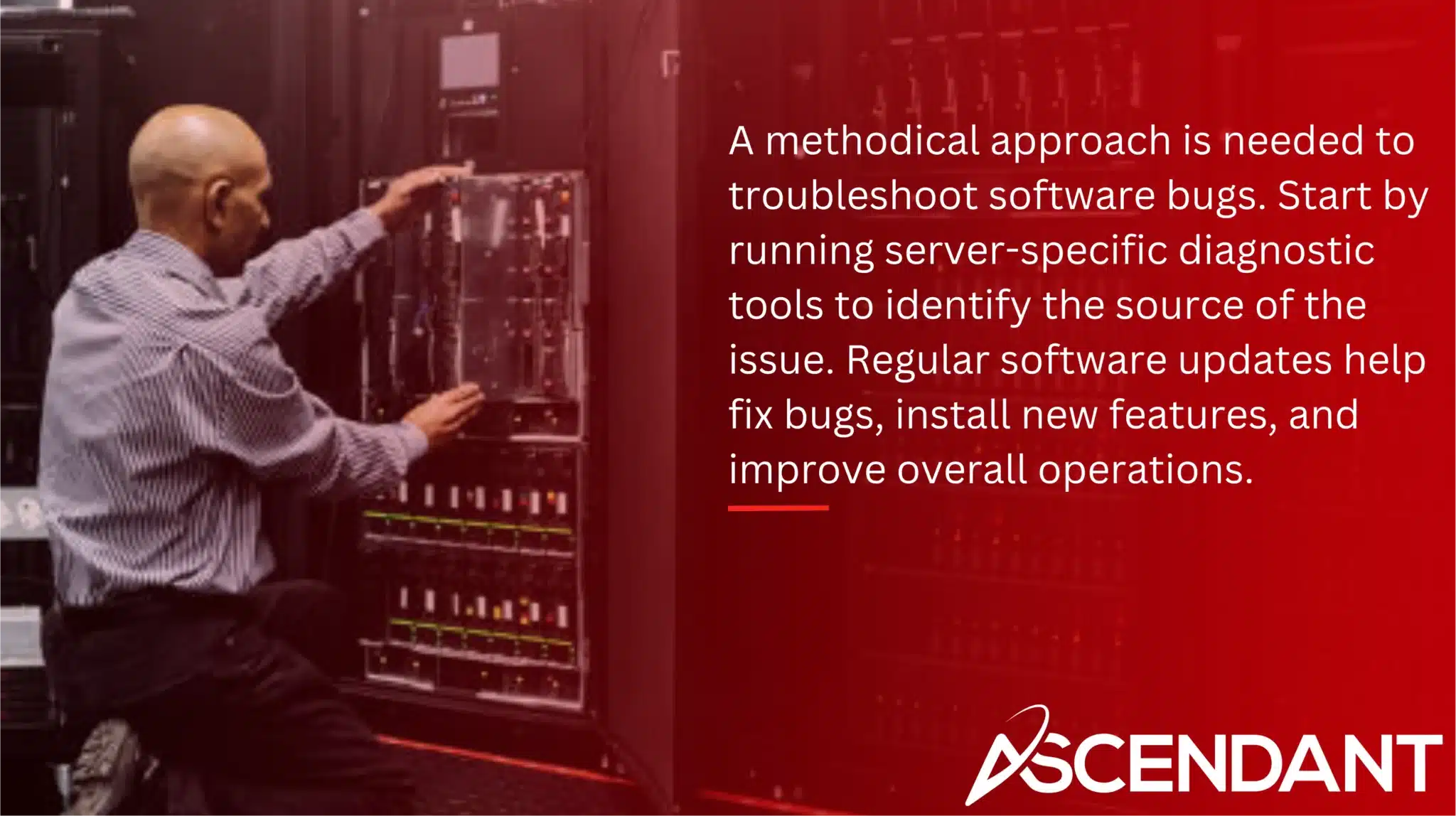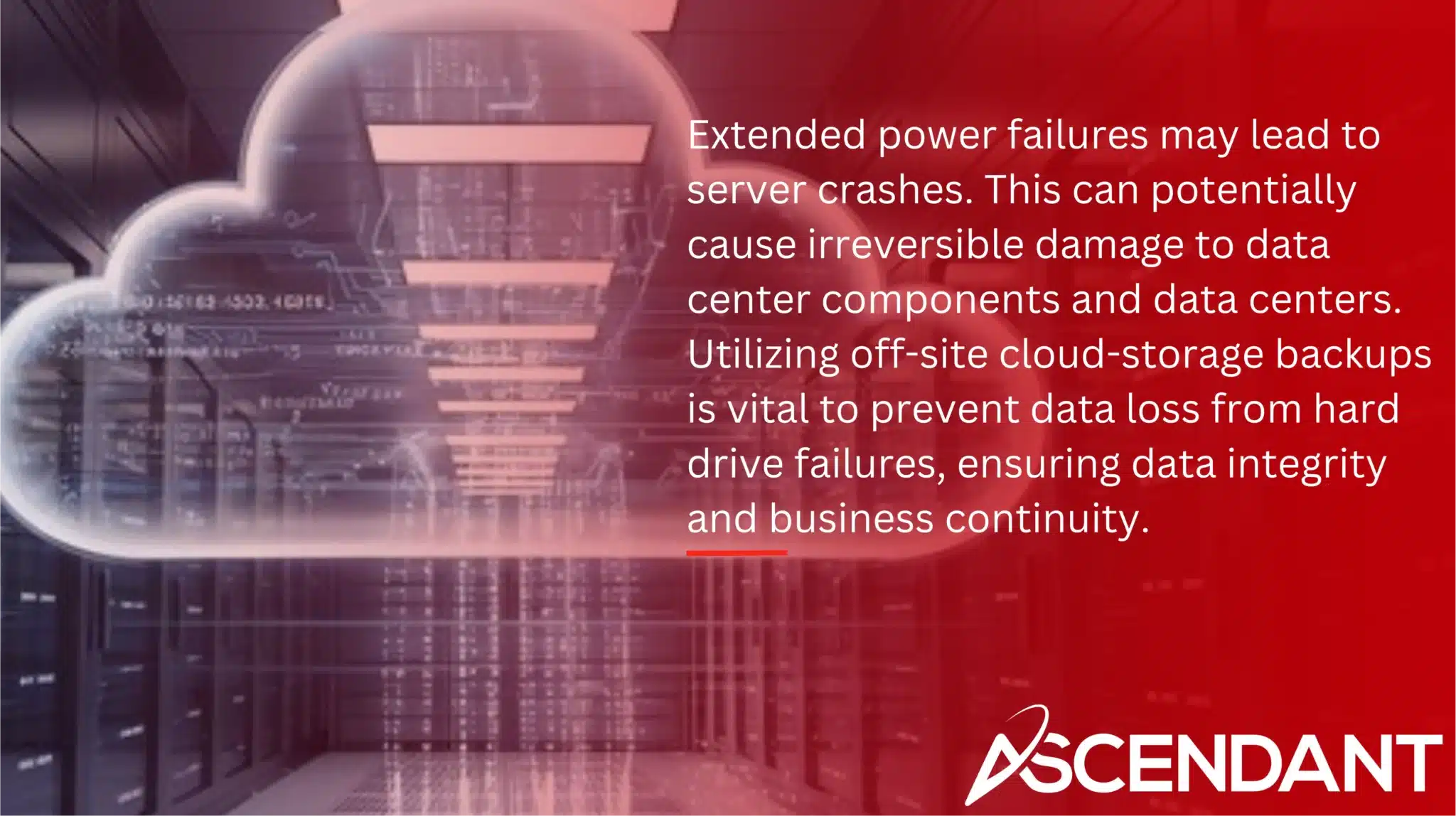Is your server experiencing frequent issues? Knowing the common server issues like hardware failures, software bugs, and network problems can help you keep your server running smoothly. This article outlines these problems and offers troubleshooting tips to resolve them.
In This Article:
- Identifying Hardware Failures
- Addressing Software Issues
- Network Connectivity Challenges
- Performance Bottlenecks and Optimization
- Security Vulnerabilities and Threats
- Server Crashes and Data Recovery
- Importance of Regular Server Maintenance
- Server Configuration Errors
- Environmental Factors Affecting Servers
- Handling Power Supply Issues
Key Takeaways
- Identifying and addressing hardware failures through diagnosis and regular maintenance is essential for server reliability and performance.
- Regular software updates and troubleshooting methods can mitigate software issues that degrade server functionality and security.
- Controlling environmental conditions and ensuring a reliable power supply are critical to preventing server crashes and maintaining optimal performance.
Identifying Hardware Failures
Server issues often originate from hardware failures, with frequent culprits being aging components like hard drives, power supply units, and motherboards. These components are susceptible to various failure causes such as overheating, physical impacts or electrical problems. If these hardware failures aren’t addressed promptly, they can lead to reduced server performance or cause unexpected downtime and total server failure.
Ensuring the system’s reliability involves precise identification and resolution of any existing hardware issues. To prevent operational disruptions within a business setting, maintaining the health of your server through routine upkeep and implementing failover strategies is crucial for keeping the server hardware functioning effectively.
Diagnosing Hardware Issues
To start diagnosing hardware issues, a meticulous visual examination is essential. Search for clear indicators of complications like disconnected parts or any physical damage to the elements. Often, this primary assessment can expose the root cause of an issue, bypassing the necessity for intricate diagnostic tools.
When dealing with more subtle problems, it becomes crucial to utilize hardware diagnostic tests. These instruments are adept at precisely identifying which critical components are malfunctioning and rectifying them promptly before they escalate into major concerns.
Consistent upkeep and vigilance in monitoring play pivotal roles in detecting prospective issues swiftly, thereby ensuring your servers remain dependable and operate optimally.
Addressing Software Issues
Server issues can arise from a variety of software-related complications, just as they do with hardware malfunctions. These issues commonly encompass conflicts between incompatible applications, data corruption within files, and disruptions in the operating system’s functionality. Server problems are sometimes exacerbated by obsolete drivers or improper allocation of system resources. Thus, highlighting the importance of ongoing upkeep and updates.
Keeping software up to date is crucial since older versions may contain security gaps that cybercriminals could potentially leverage for malicious purposes. By instituting routine updates to your software infrastructure, you fortify your servers against such vulnerabilities while promoting their reliable and secure performance.
Troubleshooting Software Problems

A methodical approach is needed to troubleshoot software bugs. Start by running server-specific diagnostic tools to identify the source of the issue. Regular software updates help fix bugs, install new features, and improve overall operations.
Server error codes, including the 500 Internal Server Error, signal potential issues. These problems may arise from server configuration or the application code. Utilizing server and network monitoring tools can help identify software issues, server errors, and system errors by reviewing server logs and checking for driver updates to avoid compatibility problems.
Network Connectivity Challenges
Issues with network connectivity can profoundly affect the efficiency of server performance, resulting in sluggish data transfer speeds, ineffective communication between clients and servers, and potentially leading to total server downtime. Frequently encountered sources of such issues include improper setups within the network, erroneous firewall configurations, failures related to DNS servers, and problems linked to server connections. These complications may arise directly from the server or through associated hardware like routers and switches. To these internal factors, external dangers including cyber-attacks have the potential to impede network connectivity and thereby deteriorate overall server performance.
It is critical for maintaining business operations uninterrupted and ensuring system reliability that any emerging network difficulties are addressed swiftly. By ensuring correct configuration as well as conducting consistent upkeep on your networking infrastructure helps avert disruptions before they occur.
Resolving Network Issues
To address network issues, it is crucial to first examine the server’s physical connections to make sure they are secure. Inspect for any defective cables or hardware problems and verify that IP settings, DNS resolutions, and DHCP allocations are correctly configured at the physical layer.
It is equally important to review the configurations of firewalls and routers. Confirm that all required ports have been opened, and inspect VLAN setups as well as subnet structures for uniformity across your network. Utilizing network diagnostic tools along with monitoring software can assist in pinpointing communication breakdowns within the network infrastructure leading to its enhanced stability and performance.
Performance Bottlenecks and Optimization
Server performance can be significantly hindered by performance bottlenecks, resulting in prolonged response durations and diminished effectiveness.
The typical culprits include:
- Issues with software
- Programs that are no longer up-to-date
- Applications demanding high resources
- Insufficient capacity
- Overwhelming traffic
Such elements may lead to an overburdened system, which necessitates tuning to mitigate these problems.
Keeping a close watch on server performance is essential for pinpointing the sources of bottlenecks and guaranteeing the server operates at peak efficiency. Consistent upkeep, involving tracking how system resources are used, can aid in recognizing looming difficulties before they disrupt services—thereby sustaining business productivity and operational excellence.
Enhancing Server Performance
Utilizing network management instruments and performance analysis systems is essential in improving server performance, as they aid in observing and pinpointing problems. By examining event logs and system capabilities, these tools shed light on issues related to software that could impact overall function. Employing diagnostic utilities tailored for servers helps detect defective hardware components which are often at the root of performance dilemmas.
To enhance how a server manages its load, it’s important to keep track of utilization across RAM, CPU, and bandwidth. If necessary, upgrading these hardware elements can contribute positively to balancing resources more effectively. To ensure applications remain stable and dependable after adjustments are made or new features are implemented. Comprehensive evaluation prior to rolling out updates is crucial.
Security Vulnerabilities and Threats
Security vulnerabilities present substantial threats to server infrastructure, with potential consequences like data breaches, illicit access permissions, and interruptions in operations. Typical digital security hazards include ransomware attacks, malware infiltration, phishing scams, and incidents of data compromise that may take advantage of misconfigurations within the server setup or exploit insufficiently robust passwords.
Issues with network connectivity can also introduce security weaknesses by disrupting communication between clients and servers and potentially leading to the exposure of sensitive information. The presence of outdated software amplifies susceptibility to breakdowns and exploitable flaws. Consistently applying updates is crucial for maintaining rigorous standards of server security.
Implementing Robust Security Measures
Establishing strong security measures requires consistent updates to security software and careful management of patches to defend against emerging threats. It is essential for the maintenance strategy that aims at prevention, to conduct timely software updates and create backups. These steps are vital in maintaining system dependability and ensuring the ongoing operation of a business.
Performing penetration testing is crucial for detecting potential weak points in server defenses before they can be taken advantage of by malicious actors. Regular assessments of server configurations carried out by IT departments ensure adherence to established security protocols. Enforcing rigorous policies on file permissions greatly diminishes the likelihood of sensitive data being compromised or accessed without authorization.
Server Crashes and Data Recovery
Server crashes can have devastating consequences, including significant data loss and operational disruptions. Common causes include:
- Power outages
- Hardware faults
- Maintenance activities
- Unexpected hardware failures
- Software errors
- Cybersecurity threats
These factors can lead to server crashes, emphasizing the need for a robust disaster recovery plan.

Extended power failures may lead to server crashes. This can potentially cause irreversible damage to data center components and data centers. Utilizing off-site cloud-storage backups is vital to prevent data loss from hard drive failures, ensuring data integrity and business continuity.
Routine server maintenance helps ensure operational stability and mitigates the risk of unexpected issues, keeping your server operations and server infrastructure running smoothly while managing server loads through effective server management.
Recovering from Server Crashes
To mitigate the impact of server crashes, it is vital to adopt a proactive stance. Ensuring regular maintenance of servers plays an essential role in warding off prevalent server issues, thereby maintaining uninterrupted business operations. It’s important to carry out periodic inspections, keep both hardware and software current, and vigilantly oversee the well-being of your servers to minimize unforeseen downtime and extend their operational life.
Employing uninterruptible power supplies (UPS), surge protectors, and standby generators is instrumental in providing steady electricity flow and safeguarding against electrical disruptions. Such measures help avert crashes that can lead to data loss while simultaneously guaranteeing the dependability of your power supply unit.
Importance of Regular Server Maintenance
Consistent maintenance of servers is crucial to avert malfunctions, guaranteeing uninterrupted business operations. Server problems can majorly hinder work productivity and efficiency, resulting in revenue losses and customer dissatisfaction.
Keeping a close eye on your server through routine monitoring and updates promotes its durability and functioning capacity. Conducting frequent security checks, engaging in penetration testing, and providing ongoing education for employees are vital steps to uphold the security of the server and prevent potential complications.
Preventive Maintenance Strategies
Routine preventive maintenance includes systematic inspections of hardware components to detect issues early and enhance performance optimization. The adoption of such regular maintenance practices can greatly prolong the operational life and dependability of server hardware.
Employing tools for monitoring servers assists in promptly identifying and rectifying configuration errors. Carrying out timely server maintenance, which includes the replacement of defective parts as well as firmware upgrades, is crucial for preserving the system’s reliability.
Server Configuration Errors
Incorrect server configuration can result in a range of problems, from connection difficulties and sluggish performance to security risks and breakdowns in applications. Configuration mistakes might include erroneous file paths, SSL certificates that are not set up properly, incorrect DNS records or TCP/IP configurations.
It is essential to ensure the accuracy of server settings to maintain peak efficiency and prevent complications that could interfere with the continuity of business activities.
Fixing Configuration Errors
Regular software updates, consistent monitoring, and maintenance are crucial in correcting configuration errors. To diagnose issues related to server configuration effectively, it is beneficial to use server monitoring software and performance testing tools that help guarantee servers are set up properly.
To avert application failures and sustain system dependability, IT teams must examine the configurations of IT systems’ servers regularly. This includes validating policies and performing routine audits.
Environmental Factors Affecting Servers
Server hardware is highly susceptible to environmental factors such as dust, humidity, and variations in temperature. These elements can greatly undermine both the performance and the dependability of the equipment. High humidity levels may corrode server parts and cause short circuits. At the same time, a buildup of dust could obstruct fans and heatsinks, causing servers to overheat.
If an air conditioning cooling system fails to function properly, it might inflict harm on server components and drastically decrease their efficiency. Natural calamities like floods or earthquakes pose serious risks to the structural integrity of servers, which could lead to significant data loss.
Controlling Environmental Conditions
Maintaining server performance and dependability necessitates strict control of environmental conditions. To stave off any server issues that stem from these conditions, it’s essential to carry out consistent maintenance alongside the deployment of superior environmental control systems.
Incorporating sensors specifically designed to gauge the environment is key in keeping a close watch on factors like temperature and humidity. This vigilant monitoring assures that servers function within their ideal operating ranges, safeguarding against potential complications.
Handling Power Supply Issues
Issues with the power supply play a significant role in causing server crashes, which frequently lead to data being corrupted or lost. Several elements can precipitate such disruptions in power affecting servers, such as:
- Brief reductions in voltage (brownouts)
- Complete losses of power (blackouts)
- Electrical spikes due to severe weather conditions
- Substandard electrical setup
Electricity surges along with inadequate electrical systems can cause malfunctions within the server hardware. It is crucial to maintain a consistent and stable power source to prevent these problems. Ensuring that uninterruptible power supply (UPS) systems are regularly tested for reliability during outages is vital, just as it’s important that surge protectors have an appropriate rating for safeguarding the equipment they’re connected to.
Ensuring Reliable Power Supply
Investing in backup power solutions such as Uninterruptible Power Supply (UPS) systems and generators is crucial for providing a reliable power supply, safeguarding against electrical disruptions. Establishing a disaster recovery plan alongside failover strategies is vital to preserve business continuity amid power failures.
Integrating these backup power options with a solid disaster recovery approach is key to server reliability, guaranteeing that servers stay up and running even when faced with power outages.
Summary
In our thorough exploration of server management, we have examined the intricate aspects involved, providing insights into prevalent problems and practical solutions for their resolution. Keeping up with server performance entails a constant watchfulness and forward-thinking approach to mitigate issues like hardware malfunctions, software glitches, and network connectivity hurdles. It is imperative to stave off any potential bottlenecks in performance while fortifying your server infrastructure with strong security protocols and reliable electrical power—these are indispensable elements in shielding your system.
Adhering to a schedule of routine maintenance for servers along with employing foresighted strategies for managing them can greatly bolster the dependability of systems as well as ensure uninterrupted business processes. Grasping the array of variables that may impinge upon server functionality enables you to reduce unforeseen outages, secure critical data from vulnerabilities, and guarantee steadfast support from your servers for all facets of organizational activities. Remain alert and ahead of the curve. This is essential for maintaining seamless operations on your servers.
 Frequently Asked Questions
Frequently Asked Questions
What are the most common hardware components prone to failure in servers?
The most common hardware components prone to failure in servers are hard drives, power supply units, and motherboards.
Prioritizing their maintenance can enhance server reliability.
How can I improve my server’s performance and avoid bottlenecks?
To enhance your server’s performance and prevent bottlenecks, regularly monitor resource utilization, upgrade hardware when needed, and redistribute resources effectively.
Employing network management tools and performance analysis platforms can help diagnose and resolve potential issues.
What steps should I take to ensure robust server security?
To ensure robust server security, implement regular updates for security software and conduct penetration tests, while also auditing server settings and enforcing strict file permission policies.
These practices will significantly mitigate security vulnerabilities.
How can I recover from a server crash and prevent data loss?
To recover from a server crash and prevent data loss, it is crucial to implement regular maintenance, utilize uninterruptible power supplies, and perform routine health checks.
Taking these proactive measures ensures your server remains reliable and minimizes the risk of future incidents.
What environmental factors can affect server performance, and how can I control them?
Server performance can be significantly affected by environmental factors like dust, humidity, and temperature fluctuations. To control these factors, implement regular maintenance, utilize high-quality control systems, and install environmental sensors for continuous monitoring.

